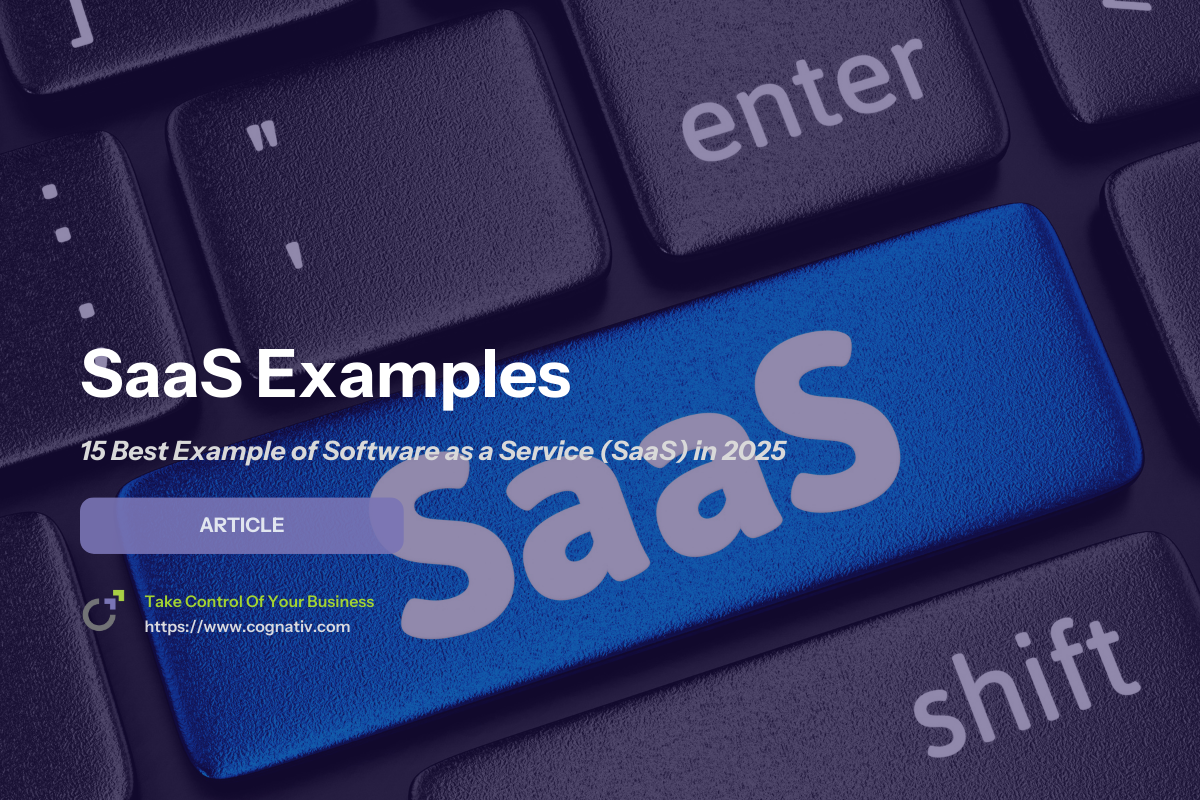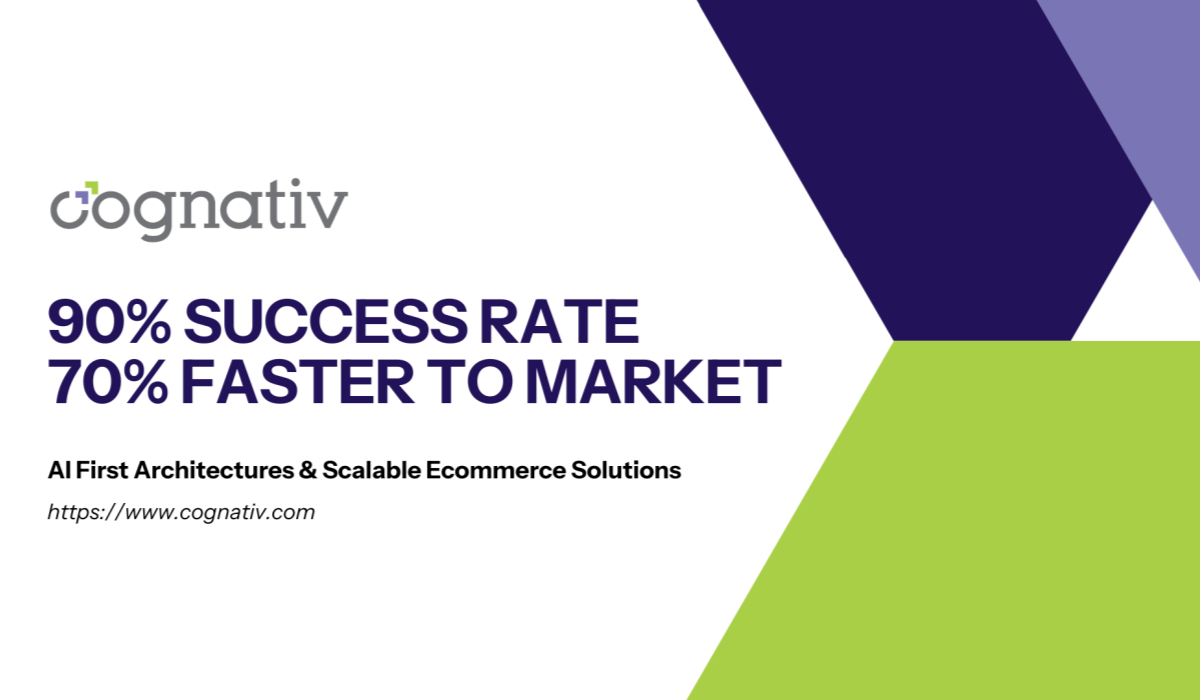15 Best Example of Software as a Service (SaaS) in 2025
Searching for an example of software as a service? SaaS is software hosted in the cloud, accessed online, and managed by the provider. No installation is needed. This article highlights 15 top SaaS examples in 2025, demonstrating their impact on business operations.
Key Takeaways
-
SaaS is a cloud-based subscription model that enhances accessibility and flexibility by eliminating the need for local installations.
-
Benefits of SaaS include cost savings, scalability, operational efficiency, and rapid deployment, making it a savvy choice for businesses of all sizes.
-
Popular SaaS applications like Salesforce, Slack, and Zoom streamline workflows and boost collaboration, while emerging trends emphasize AI integration and industry-specific solutions.
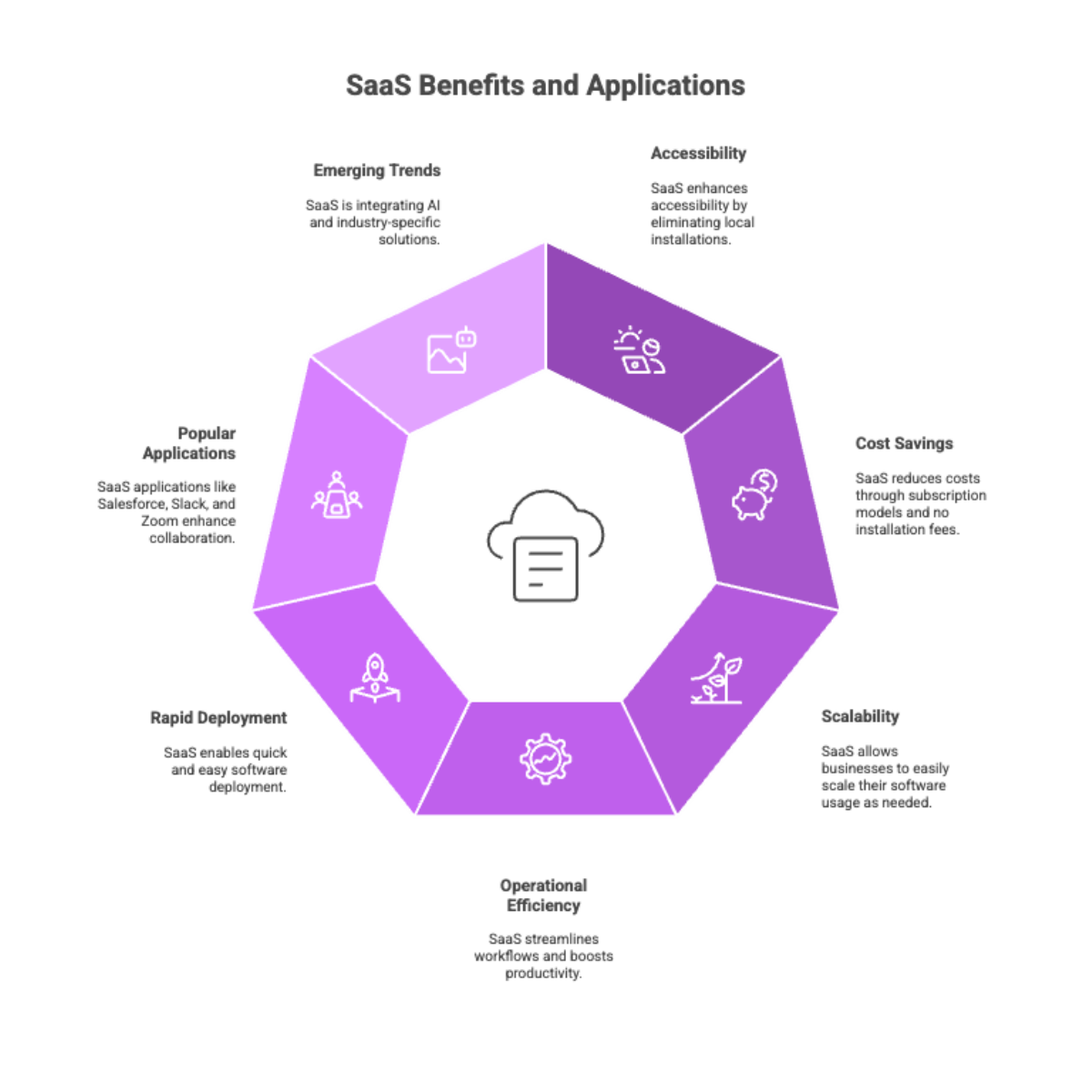

What is Software as a Service (SaaS)?
Software as a Service, or SaaS business, is a subscription based model. In this model, web based software is delivered online through the cloud. Unlike traditional software that requires installation on local computers, SaaS applications are hosted on the provider’s servers and accessed through the internet. This model transforms traditional software into a saas product that users subscribe to rather than purchasing outright, making it a form of on demand software. A saas company typically offers these software services to enhance user accessibility and flexibility.
One of the defining characteristics of SaaS applications is their global accessibility, allowing users to access services from anywhere with an internet connection. This eliminates the need for installing software on individual user’s computer, and the SaaS vendor manages updates and maintaining software, ensuring users always have access to the latest versions.
The SaaS market is booming, driven by the flexibility and scalability these solutions provide, making them a preferred choice for saas businesses looking to optimize their operations with saas vendors.
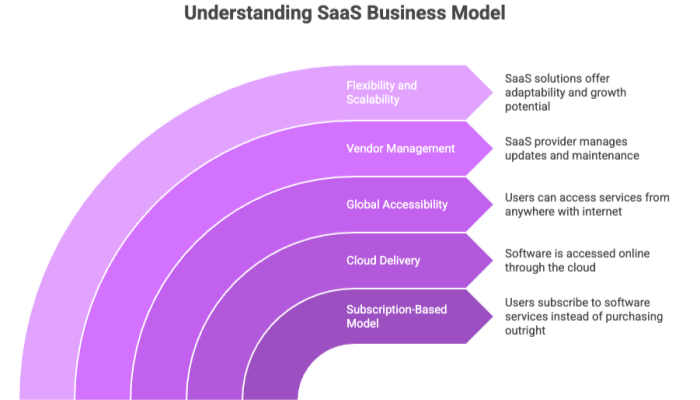

Benefits of SaaS Solutions
One of the most compelling benefits of SaaS solutions is the financial advantage they offer:
-
Reducing the need for upfront hardware, software licenses, and maintenance allows businesses to achieve significant cost savings.
-
SaaS applications are cost-effective compared to managing multiple software licenses.
-
They lead to more predictable budgeting and financial planning.
This makes SaaS a financially savvy choice for businesses of all sizes.
Flexibility and scalability are other significant advantages of SaaS solutions:
-
Businesses can easily scale their usage in response to fluctuating demands, ensuring they only pay for what they need.
-
SaaS models typically allow for automated software updates, ensuring users always operate on the latest version without manual effort.
-
This reduces the IT burden, allowing businesses to focus more on their core operations and strategic goals.
Operational efficiency is another key benefit of SaaS. Key saas advantages include:
-
Rapid deployment capability allows companies to start using the software almost immediately, speeding up the realization of benefits.
-
Suitability for businesses of all sizes, providing tailored solutions that cater to varying needs.
-
Ensures that businesses can scale and adapt as they grow.
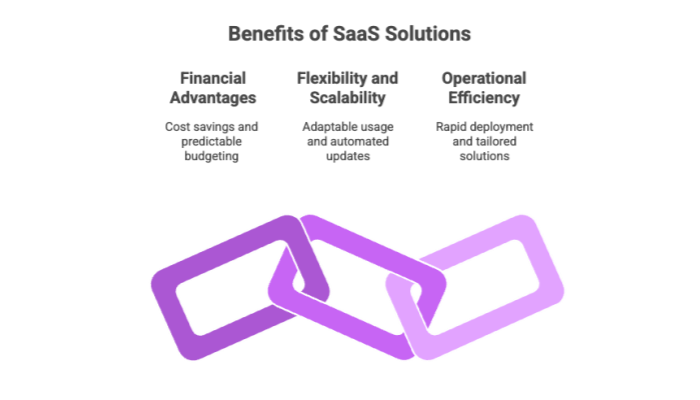

Popular SaaS Applications in 2025
In 2025, the SaaS landscape is teeming with applications designed to enhance various business processes through cloud based software solutions, cloud services, and cloud based applications. From productivity suites like Google Workspace to creative tools like Adobe Spark, the variety of SaaS applications available today is staggering. These tools are revolutionizing the way businesses operate, providing innovative solutions that drive efficiency and productivity in application development.
Among these, certain applications stand out due to their widespread adoption and impact. Salesforce, Slack, and Zoom are exemplary SaaS solutions and saas apps that have become integral to many businesses’ operations.
These platforms not only streamline workflows but also foster better communication and collaboration, making them indispensable tools in the modern business environment.
Salesforce
Salesforce is a leading salesforce crm platform that helps businesses manage customer relationships, sales, and marketing efforts through comprehensive tools and integrations. With over 150,000 businesses using Salesforce, its extensive adoption in the market is a testament to its effectiveness and versatility. The platform provides tools for managing and integrating every aspect of business operations, promoting conversions, and providing a holistic view of customer needs.
Key features of Salesforce include:
-
Its ability to prioritize conversions and enhance customer satisfaction.
-
Integration of sales, service, and marketing functions seamlessly.
-
Enabling businesses to manage customer relationships more effectively.
This not only boosts existing customers’ satisfaction but also drives business growth in the business world, making Salesforce an invaluable tool for modern enterprises, contributing to business success.
Slack
Slack is a messaging app designed for team communication and project organization. It offers key features such as:
-
Instant messaging
-
Organized channels for discussion
-
File sharing These features make it an essential tool for team collaboration. Slack provides a platform for real-time communication, reducing reliance on traditional email and streamlining workflows, thus improving productivity.
What sets Slack apart is its unique selling proposition of providing faster, more organized, and more secure communication compared to email. The platform’s organized channels facilitate project management by allowing teams to focus discussions on specific topics, ensuring that communication is both efficient and effective.
Zoom
Zoom is widely recognized as a cloud-based video and audio conferencing platform that facilitates seamless remote communication. With key features such as HD video quality, screen sharing, live chat functionalities, and mobility options, Zoom enhances collaboration and enables businesses to conduct virtual meetings effectively through video conferencing.
The platform allows users to host webinars and large meetings, making it a preferred choice for virtual events. Whether it’s a small team meeting or a large conference, Zoom’s robust features ensure that users have a reliable platform and high-quality communication experience.
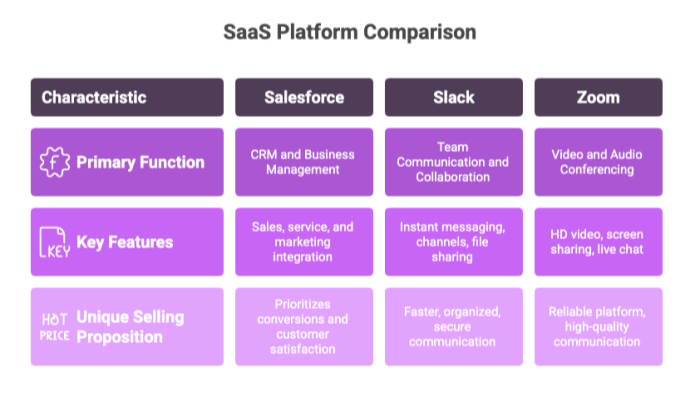

Emerging SaaS Trends in 2025
As we move further into 2025, several emerging technologies are shaping the SaaS industry. One significant trend is the integration of AI in SaaS, which enhances user experiences through personalized recommendations and automation. Platforms like Tableau are incorporating AI-powered analytics to improve decision-making processes across organizations.
Vertical SaaS platforms tailored for specific industries, such as healthcare and finance, are also gaining traction. These platforms provide customized functionalities that address the unique needs of different industries, offering more specialized solutions as a service provider.
Additionally, SaaS providers are focusing on advanced security measures, like Zero Trust Architecture and end-to-end data encryption, to protect user data.
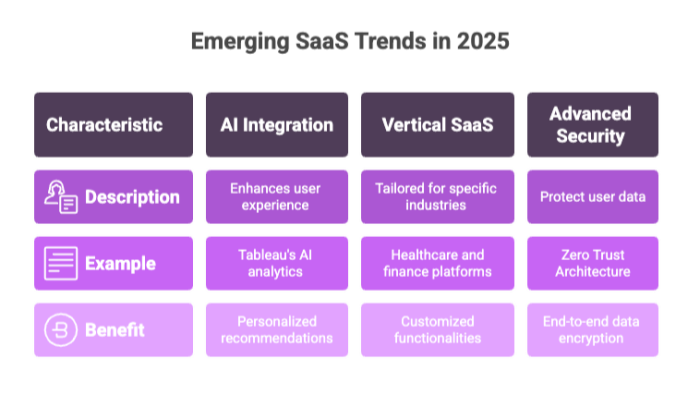

SaaS and Project Management Tools
SaaS applications are revolutionizing project management by supporting remote working and facilitating real-time collaboration among users across multiple tools and devices. Tools like Asana and Trello enhance productivity by enabling teams to access tools and data from any location, improving operational flexibility and efficiency.
With SaaS platforms, project managers can monitor project progress in real-time, facilitating immediate adjustments and better task management. These tools also provide features for task organization and workflow automation to automate processes, making them indispensable for modern project management.
ClickUp
ClickUp is a leading project management software and an all-in-one productivity platform. It is utilized by companies of all sizes, from solopreneurs to large enterprise teams. ClickUp consolidates various apps, organizes and automates workflows, and provides 24/7 customer support, making it a versatile tool for managing tasks and projects efficiently.
Whether it’s task management, time tracking, or goal setting, ClickUp offers a comprehensive suite of features that cater to diverse project management needs. Its user-friendly interface and robust functionality make it a favorite among businesses looking for an integrated project management solution.
Asana
Asana is a project management tool that helps teams organize tasks efficiently. It offers features such as:
-
Customized permissions
-
Assigned tasks
-
Managing deadlines
-
Dividing responsibility to enhance team collaboration
Asana’s visual timeline feature helps teams plan and manage tasks over a set duration, ensuring that projects stay on track and deadlines are met.
Asana enhances communication and coordination among team members by offering a clear overview of project timelines and responsibilities. This makes it an invaluable tool for teams looking to improve their project management processes and achieve their goals more effectively.
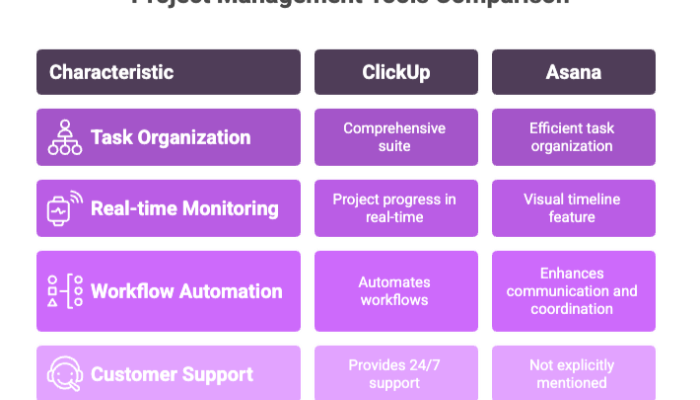

SaaS in Data Management and Analytics
SaaS solutions are transforming the landscape of data management and data analytics by providing businesses with advanced tools to handle and analyze large datasets effectively. Platforms like Salesforce offer a comprehensive suite of services that include analytics and marketing automation, helping businesses leverage customer data-driven insights to drive growth and improve customer experiences.
These SaaS platforms streamline data management processes, allowing users to access and analyze data storage without the need for extensive on premises software infrastructure. SaaS solutions empower businesses to make informed decisions and stay competitive by enabling real-time data analysis and fostering a data-driven culture on a cloud based platform, including options for cloud storage.
Tableau
Tableau is an end-to-end analytics platform that transforms data into actionable insights. Its key features include:
-
Supporting data visualization, allowing organizations to convert raw data into comprehensible formats for better insights.
-
Enabling businesses to create interactive dashboards that visualize data trends in real-time.
-
Making it easier to identify patterns and make data-driven decisions.
Tableau fosters a data-driven culture within organizations through comprehensive analytics. This enables teams to collaborate more effectively and leverage data to drive business growth and innovation.
Databox
Databox is a business analytics platform that gathers business data from multiple sources into a centralized dashboard. Key features include tracking performance, offering reporting software capabilities, and supporting integration with over 100 applications, enhancing its data connectivity. These features enable marketing teams to gain real-time insights and make informed decisions.
The platform emphasizes data centralization, allowing users to track business performance in one unified dashboard. This enhances efficiency and decision-making, making Databox an indispensable tool for data-driven businesses.
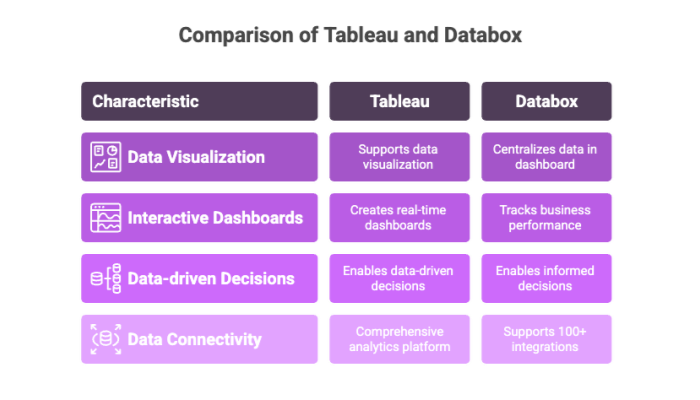

SaaS for Customer Support and Engagement
SaaS solutions are revolutionizing customer support and engagement by providing tools that enhance communication and streamline customer management processes. Platforms like Salesforce and Freshdesk offer comprehensive features for managing customer relationships and providing multi-channel support. These tools enable businesses to respond to customer inquiries more efficiently and provide personalized interactions, boosting customer satisfaction.
HubSpot is another notable SaaS application that combines CRM with marketing automation, enhancing customer relationship management and facilitating team collaboration. SaaS platforms improve customer engagement strategies by centralizing communication and offering automated support features.
Zendesk
Zendesk is a customer service platform that provides scalable support options and focuses on streamlining customer service and managing customer relationships. Its unique selling proposition is its emphasis on customer relationships, positioning itself as a service-first CRM company.
With features such as a call center, knowledge base, and advanced IM tools, Zendesk supports scaling customer interactions and enhances the customer experience by providing a personalized approach. It is particularly suitable for small to medium-sized businesses looking to centralize their customer interactions for better documentation and resolution.
Intercom
Intercom provides capabilities to gain insights, send targeted messages, and engage customers through personalized conversations and automated support. Intercom enhances customer communication and engagement by leveraging behavioral targeting, ensuring businesses deliver the right messages at the right time.
This platform simplifies and enhances customer engagement strategies, making it easier for businesses to gather feedback and improve their services. Whether it’s through live chat, email, or in-app messaging, Intercom provides a comprehensive solution for customer communication.
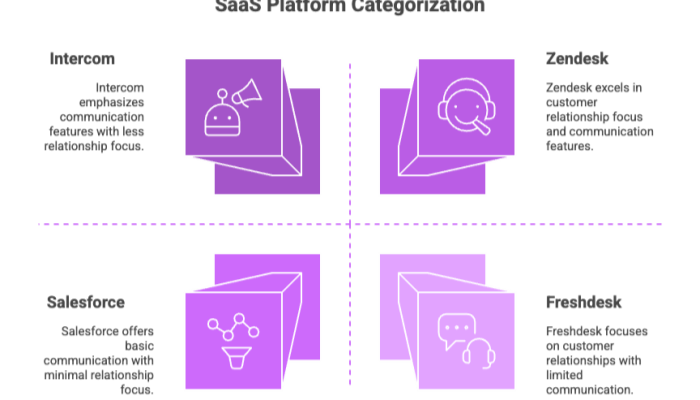

SaaS in E-commerce
SaaS solutions are revolutionizing e-commerce by simplifying online store management and providing essential tools for business growth. Key features of platforms like Shopify and BigCommerce include:
-
User-friendly interfaces
-
Extensive integrations that make it easy for businesses to manage their online stores effectively
-
Enhanced customer experiences through improved personalization
-
Streamlined purchasing processes
With over five million online stores supported and integrations with over 13,000 apps, Shopify is a prime example of how SaaS is transforming the e-commerce landscape. SaaS e-commerce platforms enable businesses to scale and adapt with ease by providing a comprehensive technological framework for online retailing.
Shopify
Shopify is an e-commerce platform designed for managing online stores, providing businesses with a comprehensive technological framework for online retailing. With a G2 rating of 4.4 out of 5, Shopify reflects high user satisfaction and reliability.
Setting up an online store with Shopify can take less than 30 minutes, making it accessible for new users. Its user-friendly interface and robust features, like drag-and-drop functionality, help businesses streamline their sales processes and manage their stores effectively.
BigCommerce
BigCommerce is a leading e-commerce platform that provides a range of tools to help businesses create and manage their online stores. The platform offers robust analytics, customizable storefronts, and various integrations that cater to businesses of all sizes.
With advanced SEO features, BigCommerce optimizes online stores for better visibility and search rankings. It also supports multiple payment gateways and includes various marketing tools to facilitate business growth, making it a versatile solution for e-commerce businesses.
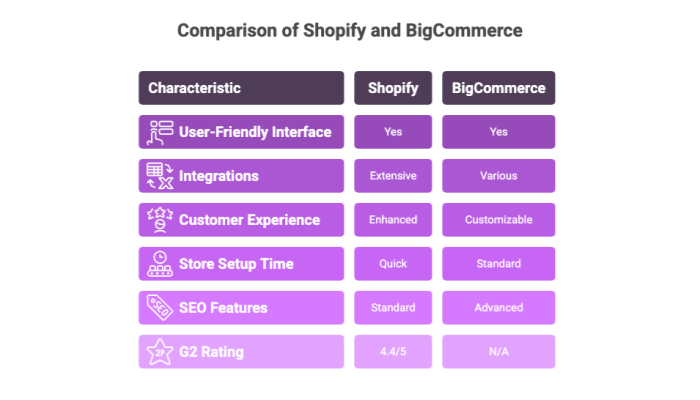

Security and Compliance in SaaS
Security and compliance are critical considerations in the SaaS industry. Many SaaS providers offer built-in security measures and data encryption to protect user data, ensuring a higher level of data protection than many businesses could achieve independently. These features include data encryption, regular backups, and adherence to industry regulations, which are essential for maintaining data security and integrity.
Security frameworks such as SOC 2 and ISO/IEC 27001 establish robust controls for data confidentiality and integrity in SaaS, providing a secure platform for business operations. Regulatory compliance, including GDPR, HIPAA, and CCPA, enforces user data protection and privacy protocols in SaaS applications, fostering user trust and ensuring legal compliance.
However, managing compliance can be challenging due to evolving regulations and the need for ongoing security assessments to adapt to emerging threats. Implementing SaaS Security Posture Management and automating compliance processes help reduce errors and ensure consistent adherence to regulations across operations.
Establishing a solid incident management process enables quick response to security breaches, minimizing potential damage. Regularly reviewing and enforcing compliance policies ensures they remain effective and relevant to the current regulatory landscape, protecting sensitive information and maintaining user trust.
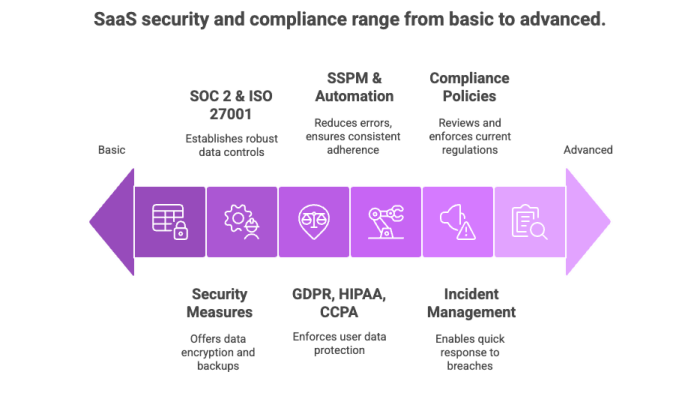

Choosing the Right SaaS Solution for Your Business
Choosing the right SaaS platform is crucial for meeting unique business requirements and ensuring effective management and automation. Planning for onboarding and implementation helps select a SaaS solution that aligns with business goals and simplifies workflows, significantly impacting productivity, growth, and enterprise resource planning customer acquisition.
Ensuring that the chosen SaaS solution integrates seamlessly with existing technology is essential for efficiency.
The platform should be customizable to fit specific business needs through its wide range of integrations, enhancing customer engagement and contributing to predictable revenue.
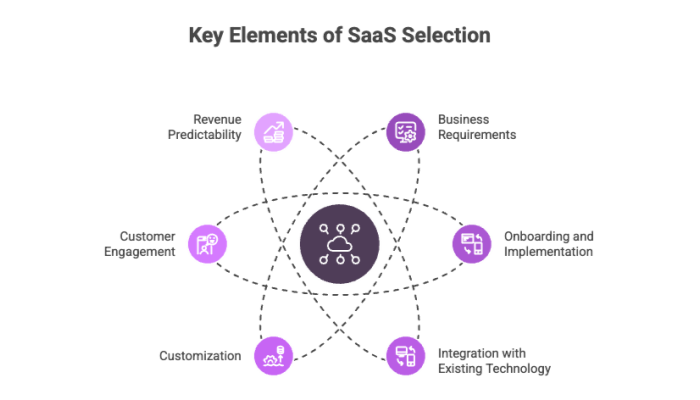

Summary
In summary, SaaS solutions offer numerous benefits, from financial savings and scalability to enhanced operational efficiency and real-time collaboration. Salesforce, Slack, Zoom, and other popular SaaS applications exemplify how businesses can leverage these tools to drive growth and improve productivity. Emerging trends like AI integration and vertical SaaS platforms are shaping the future of the industry, providing more specialized and secure solutions.
Choosing the right SaaS platform is paramount for business success. By understanding the unique needs of your business and selecting a solution that aligns with your goals, you can unlock the full potential of SaaS. As we move forward, the continued evolution of SaaS promises to bring even more innovative solutions that will redefine the way businesses operate and succeed.

Frequently Asked Questions
In this section, we address common questions about software as a service (SaaS), including what saas defined software entails, its benefits for small businesses, and how saas providers handle crucial aspects like software management and software maintenance.
We also highlight popular saas products such as Google Docs and Salesforce CRM, discuss the importance of security patches, and explain how saas platforms integrate essential software tools like content management systems and email marketing tools to support business growth and operational efficiency.
What is Software as a Service (SaaS)?
SaaS is all about delivering software online through the cloud, so you can use applications without needing to install anything on your devices. It’s a convenient way to access the tools you need anywhere, anytime.
What are the benefits of using SaaS solutions?
Using SaaS solutions can save you money, provide scalability to grow with your needs, enhance operational efficiency, and keep your software up to date automatically. It's a smart choice for anyone looking to streamline their business processes!
What are some popular SaaS applications in 2025?
In 2025, some popular SaaS applications are Salesforce, Slack, Zoom, Google Workspace, and Adobe Spark. These tools are essential for collaboration and productivity in today's digital workspace.
How do SaaS platforms ensure security and compliance?
SaaS platforms prioritize security and compliance by implementing strong data encryption, following industry regulations, and conducting regular security assessments. This approach helps keep your data safe and meets necessary standards.
How can I choose the right SaaS solution for my business?
Choosing the right SaaS solution boils down to understanding your business needs, ensuring it fits well with your current tech, and planning for a smooth onboarding process. Always keep your business goals in mind!

